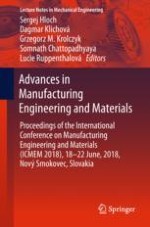2019 | OriginalPaper | Chapter
The Influence of the Application of EP Additive in the Minimum Quantity Cooling Lubrication Method on the Tool Wear and Surface Roughness in the Process of Turning 316L Steel
Authors : Radoslaw W. Maruda, Stanislaw Legutko, Jolanta B. Krolczyk, Szymon Wojciechowski, Wlodzimierz Kot
Published in: Advances in Manufacturing Engineering and Materials
Publisher: Springer International Publishing
Activate our intelligent search to find suitable subject content or patents.
Select sections of text to find matching patents with Artificial Intelligence. powered by
Select sections of text to find additional relevant content using AI-assisted search. powered by
